
BOBBY MARIN
WE'VE GOT A GROOVY THING GOING (Vampisoul VAMPI 302 2LP)
This is the first time Bobby Marin's name has appeared on the front cover of an album. Throughout the Latin boom of the 60s and 70s, when Latin soul, funk, boogaloo and salsa were riding high on the charts and blasting from the airwaves, Bobby Marin was the man behind the mixing desk, producing some of the biggest hits of the era by the likes of Louie Ramírez ("Lucy's Spanish Harlem"), the Ghetto Brothers, Ricardo "Richie" Marrero ("What I Feel"), Los Africanos ("Do It"), and notably the smash hit "Cisco Kid" by La Crema, which are all here. The irrepressible riff of "Cisco Kid" also seems to inhabit "Takin over" by La Cucaracha Brass, from 1968, which appeared earlier. La Crema (like England's Cream) consisted of top musicians including Louie Ramírez (vibes and percussion), Jimmy Sabater (vocals, timbales), Andy Gonzalez (bass) and Steve Berrios (drums). If you have forgotten how to do the Boogaloo then you've certainly forgotten the Shingaling, another dance craze of the era, but you might recall it from the movie I like It like That which documented those times. I guess it was a conscious decision to sing mostly in English for these acts, to broaden the audience, but the grooves are unmistakably Latin. It was a great idea to compile 24 of Marin's hits because there is a continuity as well as great variety. The Ghetto Brothers' "Got this Happy Feeling" sounds familiar, though I was not aware of them back in the day. It's Ghetto power from the Bronx, they assure us in a spoken commentary over the various solos. This really jams. (You can also find their full-length 1972 album of Puerto Rican ghetto funk on bandcamp with the scorching "Mastica, chupa y Jala.") As in any popular music from the late sixties and early seventies, there are echoes of Manu Dibango, late Motown, Curtis Mayfield, Isaac Hayes, even Burt Bacharach in the slow numbers, but it's all taken up a notch by the Latin grooves. The original "Cisco Kid" (later covered by War) is a blast, complete with a crowd of people in the studio having a party.

ORQUESTA OLIVIERI (Vampisoul VAMPI 301)
The expression "low-rider soul" conjures up a lot of images — to do with hot summers in the city, car radios, bongos in the back, and much more. This album, a one-shot by a band and label who vanished as soon as they appeared in 1972, features a gem of the genre, "There's no other girl." It appeared as a single and then had organ overdubbed for the album to deepen the soul quotient, which pours out of the speakers with a smoky slow groove, the horns punctuating the laid-back groove, which has boogaloo backing the sweet vocals. Then we head to the first of three guaguancós, "Cuando llegué a Borinquen," which likewise balances bouncy percussion on timbales and congas with punchy horn lines. Bobby Marin was the producer and you'd think this would have taken off, but it was the time of the Fania revolution and many little labels came and went in their shadow. Alternating between ballads and driving, spiced-up tracks may not have pleased listeners who might have preferred grouping the hot tracks together. Who knows? The B side kicks off with a cha-cha-cha "María Isabel," which sounds dated. They cover "Tibiri tabara" and end with another soulful ballad, but I reckon it was their first single that clicked, and that will bring DJs to this disc.

¡SAOCO! vol 1 (Vampisoul VAMPI 283)
I thought I had reviewed this the first time around, in 2012, but looking at my Puerto Rico page I see it was volume two I wrote up. This is a reissue of the groundbreaking 3xLP set of Puerto Rican Bomba and Plena from 1954 to 1966. This style became popular in the USA as the Cuban embargo began to bite and bands from Havana were unable to tour. Cortijo y su Combo is the big name on here, with vocalist Ismael Rivera (who kick the set off with the now-classic "El Bombón de Elena"), but there are other stars like Canario, Chivirico and Mon Rivera (I always read it as "Moon River"). It's uptempo Latin music in the salsa ballpark which is kept alive today by the energies of groups like Son Mujeres Orquesta and Plena Libre, a wonderful contemporary band who still tour North America. For this remake, Vampisoul have remastered the sound and compressed the album to two LPs without losing any tracks (keeping the overhead down). "Carbón de Palito" by Moncho Leña, like "¡Aló! ¿Quién ñama?" has a very droll delivery including really fast singing which becomes undecipherable in a humorous way. I guess you have to hear it to get what I am saying. It must have gone over well at the time and I wonder if people still mimic it to this day. The speedy tongue-twister delivery is also a facet of "Karakatis Ki" by Mon Rivera. Some salsa favorites like "Cúcula" are given a fresh airing. There is also "Y Pedro Flores" by Cortijo, credited to Arsenio Rodríguez, but I don't know the original; I suspect it is a typo and they forgot to list the song title! Cortijo's "Calypso, Bomba y Plena" is very anthemic; in fact so many of the tunes on here are instantly memorable. Though they may be unfamiliar, there is a comforting feel to "Sacude Zapato Viejo" (or shake your old shoes) by Odilio Gonzalez. The tres in "El Gallo Espuelérico" by Monse Garcia sounds Cuban, but the accordion brings it back to Puerto Rico. Accordion and clarinet duet on "Te Están Vacilando" by Ramito, who is another well-known performer from the island. This is a solid collection and definitely worth investigating.
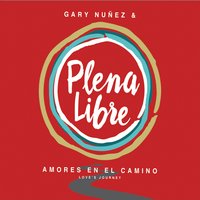
PLENA LIBRE
AMORES EN EL CAMINO (LOVE'S JOURNEY) (GN Musica)
Puerto Rico has a rich culture, including distinctive music, known as Bomba and Plena, of which the best known exponents are this band Plena Libre. The country was devastated by hurricane Maria last year and still has not recovered, despite the buffoon-in-chief going there to throw paper towel rolls to them. Considering the lack of electricity, running water and other basic needs, the band has produced a fiery rootical album full of hope and pride. Bandleader and bassist Gary Nuñez has brought in some younger players to reinvigorate their ranks and keep it driving hard. There are also contributions from legendary trumpeter Luis "Perico" Ortiz, and other guests. Drumming is to the fore and the Latin jazz-tinged set is permeated with Afro-Caribbean roots. Fans of salsa will also find enough to kick up their heels with the bomba tracks. The plena is the focus of "Recordando a un amigo," which is call and response vocals over claves, shekere, and hand drums. A well balanced and genuinely kicking set.
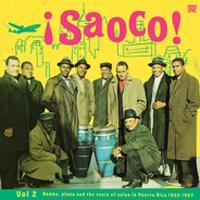
¡SAOCO! VOL 2 (VampiSoul CD152)
New York has Fania, and Puerto Rico has Ansonia, a label that encompasses all that is great about the indigenous bomba and plena, the music of the island that gave birth to salsa in the 50s and 60s. And just as New York had Hector Lavoe, San Juan Puerto Rico had Ismael Rivera who survived the 70s influx of youth bands that swept aside all the old salseros (apart from Celia Cruz). Ismael Rivera sang with Cortijo y su Combo, starting in the 50s, and they weave their magic through 8 of the 28 tracks on this excellent selection. This compilation includes examples of bomba and plena but also guaracha, rumba, merengue and mambo. While Puerto Rico exported lots of salseros to New York it was always considered Cuba's little sister, in terms of the rhythms that sprang up in the wake of the son cubano. Cortijo and Mon Rivera (another big band leader, whose name does sound a bit like "Moon River" to non-familiar ears, who came along in the 60s) would vary their repertoire and include home-grown rhythms alongside the Cuban ones, so a hybrid naturally occurred, consequently today we cannot really distinguish bomba from salsa unless we know what we are listening for. Rivera was a trombonist and helped popularize that instrument in salsa, replacing sax and trumpet with two or three trombones. In fact, the liner notes by Yannis Ruel tell us that Juan Tizol (who wrote "Perdido" and "Caravan" for Ellington's orchestra) was a Puerto Rican 'bone player. When they call out "Charanga!" you know what's afoot, but they were versatile enough to play Brazilian samba, calypso, cumbia or even dances from Venezuela or Panama. However the rise of salsa may well be connected to the blockade of Cuba, beginning in 1962, and the cessation of touring opportunities for Cuban bands to New York thereafter. One track you will recognize is "Moliendo Cafe" by Cortijo (with vocals, as opposed to Eddie Palmieri's instrumental take). The 36-page booklet is packed with info on the songs as well as old labels and picture sleeves. ¡El CD nunca morirá!
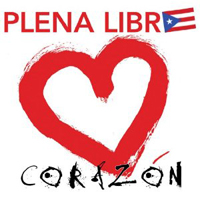
PLENA LIBRE
CORAZON (GNMX 1240)
Plena and bomba are Puerto Rican varieties of salsa, and Plena Libre seem to be the main exponents, having put out at least a dozen albums. Their latest album shows the benefits of constant touring: Plena Libre have a natural flowing energy that gets you going. This new disc is not even 40 minutes long but any more would wear you out. Gary Nuñez, the bassist, is the leader and does a lot of the writing. The addition of synth to the piano seems unnecessary and makes that hovery string-wash/noise which detracts from the cleanness of the sound. There are four singers who also play hand drums, a conguero (the excellent Gaddy Vargas), and timbalero, as well as three horn men on trombones. There's also another hand drum called pandero requinto. By the middle of the album the synth drops away and Carlos Garcia the pianist fires up on "Que es la vida" and "Hable cuembe." The later has a weird key change every fifth note in the chorus which sounds like the record is out of round, but since you can tell it's intentional, it doesn't sound wrong, just strange. Showboating or an attempt to keep the band on their toes. A great trombone solo redeems it. Things continue to heat up with "Huracán" by singer Kalie Villaneuva. If you like driving salsa you'll definitely want to check this out.
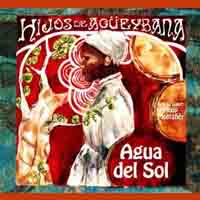
HIJOS DE AGUEYBANA
AGUA DEL SOL (Tumi Music 185)
There's a common misconception about the Cuban music known as Rumba. If you ask most people to describe rumba they will refer to Fred & Ginger in "Flying down to Rio," or Rudy Vallee singing, "When Yuba plays the rhumba on his tuba..." Truth is it's simply drum and dance music, which is also the case for Bomba. I, too, thought Bomba and its cousin Plena, were types of Puerto Rican music that were performed by full bands, but Bomba, which has its roots in African slave music, is a dialogue between singers, drummers and dancers. This group, Hijos de Agüeybana was formed to preserve some of their traditions. One of the founders was born in New York and only heard the music accidentally at a photo-shoot; the other had grown up in Puerto Rico and got into hip hop and break dancing but decided he needed to get in touch with his real roots. Like their Cuban rumbero counterparts, the participants dress in white and have definite rhythms they work with, here performed on large drums called barril and barril buleador. To prevent you getting bored there are musicians (other than drummers) who join in, and a full band on the title cut, which also features vocalist Andy Montañéz. The singing and drumming bear a slight resemblance to Cuban rumba but that's my ignorance speaking: I am sure the melodies are very different. There's guitars on the track "Loren," and shekere in addition to drums. The last track is a remix of "Te invito" with a jazz group up front suggesting further directions.

CALLE 13
RESIDENTE O VISITANTE (Sony International)
I keep looking for the summer hit, something that's gonna be my soundtrack to whatever memories this year's brighter days brings. It's always a surprise. Whether Rokia Traore or Issa Bagayogo, Gaudi & Nusrat, Luny Tunes, Electric Gypsyland a couple of years ago, Dengue Fever or Sidestepper last year, there's always a special disc. Now I am on the trail of something catchy and light. Puerto Rican duo Calle 13 fits the bill but I don't know if it will stand the test of time. It's a bit like Sidestepper: a Latin hybrid of many things, mainly cumbia and beats. It starts audaciously with what sounds like opera. Now I am not a fan of opera, in fact I hate it! And then you notice the lyrics "Cabron!" repeated and sustained, and other expletives sung in Flaccid O'Domingo style. Funny. Then it kicks into reggaeton. But there's a tango thing going on too, most intriguing. This is their third album and it has more diverse influences than their earlier efforts. Here comes a brass band intro to "La Fokin moda," I like this! More dirty words for your Spanglish vocabulary: my Mexican fourth graders would go nuts over this! "Un beso de desayuno (a kiss for breakfast)" is complexly layered and sophisticated -- like Zinfandel!-- with light Brazilian-style guitars. "Uiyi Guaye" has simplistic almost primitive new wave synth riffs; It's funny how Kraftwerk now seems like an avant-garde concept, I suppose it is the triumph of the nerds. (The title "Residente o Visitante" reminds me of a joke: an Israeli arrives at Heathrow airport and the immigration official asks him "Occupation?" No, he replies, just visiting.) A little reggaeton goes a long way, but when cavaquinho, accordeon and brass band are brought to it, it becomes engaging. There is a strong Colombian, as well as pan-Latin folk undercurrent.
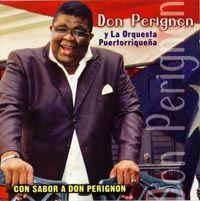
DON PERIGNON Y LA ORQUESTA PUERTORRIQUEÑA
CON SABOR A DON PERIGNON (Envidia A 70 7140)
If hot salsa is what you want in your stockings to get you bopping around on these winter days, then this jigger of Don Perignon fits the bill. I am not sure what the happy portly chap on the cover does, other than lead the band: maybe he stands in front in tails and waves a baton. The band has been around for twenty years and is guaranteed to pack the dance floor. Alumni include Andy Montañez & Roberto Roena. The singers are Rafi Andino, Pedro Brull, Rico Walker, Victor Manuelle and more. On piano are five guys including Papo Lucca (leader of Sonora Ponceña), Willie Sotelo and Luis Marin. There's a raft of trumpets (including Mario Ortiz, Jr) and trombones, several baritone saxes which always make me feel warm, along with bongo, conga and electric bass. It's classy straight-ahead salsa. They cover a few well-known tunes: Tite Curet Alonso's "Distinto y diferente" and "Don Perignon," whence the leader took his monicker, no doubt. It's a class act -- which we have come to expect from the Envidia label of Barcelona. So whether you're on the Barcalounger or taking shears to the rug, move to the groove.

PLENA LIBRE
EVOLUCION (Times Square Records TSQ CD 9048)
Plena Libre are touring to promote this, their eleventh album. If you get a chance, check them out because, good as the album is, they are smoking in concert. I was fortunate to catch the last set of their two-night stand at Yoshi's and wished I had gone earlier so I could have heard more. In concert the sound was a little muddy, but when they took it down to the percussion and vocals you got all you needed. The bandleader is the bassist Gary Nuñez & four guys take turns as lead singer so there were no big ego trips. There was piano and timbales. The pianist got to solo and showed he had the chops. On "Evolución," the title cut, he showed he could do Latin jazz as well as the percussive vamp of plena which is akin to that of salsa. And as I've said before Latin jazz usually shows more invention and versatility than the noodly mush that passes for straight-ahead jazz piano. Two trombonists were at the back of the tiny stage and rather muffled, but you can hear them clearly on the album (along with baritone sax). Nuñez took time to explain the lyrics in English and the front men even demonstrated a traditional dance where the dancer drives the conga players. He does fancy footwork and one of the drummers apes it musically. We've seen this shtick from Wolof talking drummers, even Mississippi Fred McDowell and his guitar, but this was really convincing. The two congueros, Gadwin Vargas and Charlie Pizarro, were outstanding. Pizarro was wearing "santeria" white (the others were all wearing red) & also took center stage with his small requinto and big pandero drums. The drumming kept the Afro-Puerto Rican roots to the fore. The title track is Latin jazz but Plena is the main attraction. The best song, "Tumbao," is a runaway hit. It appears in the middle of the album and segues beautifully right out of another song, "Como son las cosas" (a Bomba-Quembe about "the little things of life: relationships, etc.," that is very catchy.) "Tumbao" starts with a loping tempo which almost suggests dub (this was fantastic in concert) and then a spiraling Plena evolves as the horns jump in. On the record there is electric guitar which is unnecessary, but it certainly gets you into the "baila loco" mood. They came back for an encore and for a moment it looked as though they were going to do Reggaeton but they were just messing about and having fun while the band members all got back on stage. They did "Tumbao" as a slow ballad & basically sent themselves up before taking it up to fever pitch again. Though it's not listed on the back of the CD, there is a bonus eleventh track: a rollicking remix of "Tumbao" that takes us out in style.
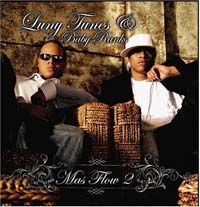
LUNY TUNES & BABY RANKS
MAS FLOW 2 (Universal 816 230 007 2)
When Don Francisco capitulated, I knew I had to go with the flow. Don Francisco, as you surely know, is host of Sabado Gigante, the world's most-watched television show, which goes out all over Latin America and the USA on Saturday nights. It's an old-fashioned variety show with skits, jiggling babes, gong show contests, makeovers, people's court, wheel of fortune (win a new car!), celebrities, and musical acts, all rolled into one overdose of Latino culture on a weekly basis. He regularly asks people simple questions, like "what kind of music do you like?" And lately they've ALL been saying "Reggaeton" to which Don Francisco (real name Mario Kreutzberger) would shrug like, Whatever... I'm too old to understand that stuff! But now he not only digs it but has been bringing reggaeton music into the show, & onto his chat show Don Francisco Presenta, on a regular basis. It's the latest flava of hip hop, sung mostly in Spanish, with reggae (dub actually) and samples, but the best part is the riffing merengue guitar from La Republica Dominicana, along with Cuban and Puerto Rican percussion, New York barrio attitude, and even Hindi filmi samples, so I asked I.J. to spin me some good reggaeton. IJ said it was a passing fad but was peaking right now (the section is as big as the Cuban section in most well-stocked stores) and he fired up Luny Tunes & Baby Ranks for me. Boy, was he on the money -- for once! (Thanks IJ I am going to overlook -- temporarily -- all that crap you've been trying to fob off on me because you get a Big Up for this one: -- Just one though!) This stuff sticks like white on rice, as Zeca Tatu is fond of saying. I am sure I'll be heartily sick of it in a few months but right now I hit the start button every time it stops! There only seem to be about two tunes on this album and about thirty-two performers, and they just keep coming back for a scratch like mosquito bites. Furthermore I can't stand the second half of the album, and, beyond furthermore, there's a second disk which I think is meant to be remixes (though that is redundant since it's all a remix). I listened to the first iteration, also a double album, and it too is the same riffs endlessly recycled. So I edited the most persistent riffs together and made my own MAS FLOW DOS-E-MEIA. There's a good drum and bass beat that emphasizes Latin percussion (timbales, cowbell, instead of drum programs) and some really awful synthesizer riffs, even a dread vocoder (I deleted those tracks). The last song is in English and is really nasty, so it goes to show, when you are not paying attention, you can get into this sh*t. Actually it only approximates English on "Oh Johnny" but the riff that won't quit gets under your skin and makes it crawl. The Duchess sniffs and says it sounds like the Macarena. In a way she's right, except the macarena had a little more to it! She adds it's just thugs and munchkins. But at least that is novel! Luny Tunes and Baby Ranks are a production duo from Puerto Rico, and they are into production in a big way, which is why I am especially grateful to IJ for narrowing the field for me: they have TWELVE albums forthcoming on their own label and also a DVD of 'nuttin but booty' in case you need to jerk off but can't stop listening to the music. The TV ads (on the Miami-based Spanish station) imply much, but it seems to be disembodied female parts, so let's not go there. Baby Ranks' "Tu Bailar" is my favourite track right now with a skittering Dominican guitar and a backbeat that reminds me of good Brasilian Pagode. And you gotta admire two grown men trying to look like Borincuan hoods in white suits and shades with the monikers Luny & Baby! The weirdly atonal Hindi-style vocal & the merciless return of the Dominican guitar are truly exciting. I can almost overlook the "Show me the way"-vocoder chorus in the background. Almost. Oddly it goes into one of those wet ballads, "Querer y amar," that I normally kill after a few seconds, but then the backbeat comes back up with a synth lead replacing the merengue guitar and I have to let it roll. It's very odd they put this out as a CD and a half. The 6 bonus tracks could easily have been worked into the first disk, but then some artists are too vain to edit themselves properly. "Querer y amar" peters out in a long fade when it runs out of steam. One of the best tracks, "El Tiburon" has a two-note quote from the JAWS theme which shows these guys do have a sense of humour. Six of 'em team up for "Mayor que yo" the first version of the wild merengue guitar track that slays me. All I can say is you'd better go with the flow and check this out for yourself, and you just might end up with a new guilty pleasure.
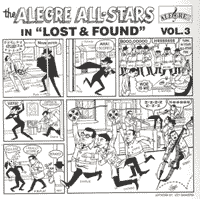
ALEGRE ALL-STARS
Vol 3: LOST & FOUND (Alegre LPA 8430)
Being a completist I have been looking long and hard for the third of the four albums recorded in the 1960s by a loose-knit group of New York Puerto Rican salseros and jazzicologists known as Alegre All-Stars. Similar in feel to Fania All Stars, though featuring instrumentalists rather than vocalists, the line-up is equally impressive: The band is co-led by Charlie Palmieri on piano and Kako on timbales (a much "realer" choice than Tito Puente); Cortijo on congas and Bobby Rodriguez on bass hold down the rhythm; "Chombo" Silva is tenor saxophonist, "Puchi" Boulong and Ray Maldonado play trumpets, and Barry Rogers is trombonist. There are assorted other percussionists and a line-up of guest vocalists including merenguero Dioris Valladares, Yayo el Indio and Cheo Feliciano.
The group was assembled by Alegre owner Al Santiago who was impressed by the spontaneity of a fifties recording titled CUBAN ALL STARS when a group of visiting Cubans were recorded jamming at a party. That album was a huge hit and he wanted to do the same for his native Puerto Rican sound. Kako was his artistic adviser & they built a stellar line-up around incendiary pianist Charlie Palmieri. Sabu Martinez was too unreliable so they got Cortijo on congas. Johnny Pacheco was too busy but recommended a classmate of his for the trombone chair. When they first got together they played ten Tuesday nights at a club in the Bronx then went into the studio. Nothing was planned: whatever they felt they played. Little bits of studio chatter between songs show how much fun they were having. It's the only album I know of that lists the bartender as a member of the band!
They open Volume 3 with a descarga called "Yumbambe," a surprisingly lyrical piece, especially when Chombo solos (quoting "Chicago, Chicago that toddlin' town") while behind him it sounds like half the Bronx is cooking away on assorted beaten things.
The Alegre All-Stars didn't take themselves too seriously which is one reason I love them. Their chops are immaculate but between songs they deride one another and make little sly asides which, with a little grasp of Spanglish, are uproariously funny. (The liner notes on how this album was lost and hence released after Volume 4 are quite mad, involving a new cataloguing system beyond belief: "We use a code number arrived at by totalling the seconds of recorded time, dividing by the amount of musicians in the rhythm section and adding the amount of bars blown by the soloist in the third track of the 'B' side of the record." They've now added a "working knowledge of the stop-watch" to the librarian's requirements to avoid further mix-ups, they explain.)
"The William Tell Overture," better known as "the Lone Ranger" theme, is quoted in the second song, a guaguanco titled "Sono sono," which gives way to the first bolero, done in a credible imitation of Beny Moré. The vibraphone player is uncredited but that's okay as I hit the "Mute vibes" button on my sound system. It's a very fifties sound. Mostly they jam on "descargas" and flare out their hottest licks while the coro finds some suitable lyric to repeat in the background. It builds and builds and when it's over you just have to start again, or put on another volume. If you haven't discovered the Alegre All-Stars you are in for a four-volume treat.
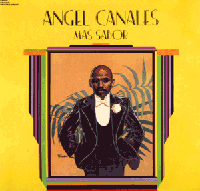
ANGEL CANALES
MAS SABOR (ASLP 6007)
Seven compositions from the pen of African-American pianist Mark "Markolino" Dimond and a band of Puerto Rican salseros relaxed and fully "in the pocket," showing how jazzy Latin jazz -- nay, salsa -- can be, if it tries. Hard to tell who's on here: certainly Andy Gonzalez on bass, maybe Willie Colon or perhaps Barry Rogers on trombone. A web search brings up the names of conga player Antonio Tapia, and bongo player Louie Rivera, who were in his band at one point. (A later band lists Nicky Marrero on timbales and Reinaldo Jorge on trombone.) Dimond has classical chops and a light shimmering touch. Very much a cooking rhythm section laying back to give the vocalist room. Canales was a long-time New Yorker, a Brooklynite since the age of ten. However he was born in Ponce, hometown of Hector Lavoe, as well as Pappo Lucca, Eddie Palmieri, "Cheo" Feliciano, and "Pete" El Conde Rodriguez. His singing was influenced by Ismael Rivera. He started out as timbales player but had to fill in for the vocalist one night and soon was in the spotlight. His first album BRUJERIA, 1970, was the basis for "Mas Sabor" reissued in 1977 by Alegre Records. Every song is a gem. "Mariquita" at 7:16 is the longest track and reminds me of the Latin Brothers, but I am partial to the whole thing. A true classic. Canales retired in 1980 when Salsa Romantica became popular & he no longer could get airplay. He moved to Miami to become a diamond-cutter. [See SALSA section for an update...]
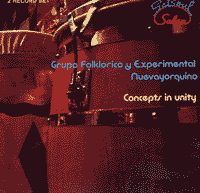
GRUPO FOLKLORICO Y EXPERIMENTAL NUEVAYORQUINO
CONCEPTS IN UNITY (Salsoul 20-60012)
Recorded in spring 1975, this two-LP set was much sought after until its reissue on remastered CD in 1994. Taking black Cuban and Puerto Rican influences from the streets of New York and melding them into a powerhouse of a band that is heavy on percussion, but nevertheless features top-flight horn-men and singers, led to an exuberant celebration like no other. No doubt Al Santiago was somewhere behind all this. Various musical styles are essayed including a mazurka! Some of the music is purely religious, addressing the Orishas. The liner notes only gives musicians' first names so you have to fill in: Chocolate on trumpet needs only one name, Milton on bata has to be Milton Cardona, Manny must be Manny Oquendo, Reinaldo Jorge on trombone adds some powerful touches. Nelson Gonzalez plays acoustic guitar and maybe that's him on tres also. There's even a harmonica player (Francisco Martinez) which reminds me of some Congolese street music. Overall CONCEPTS IN UNITY is accessible and joyous, rich and life-affirming.
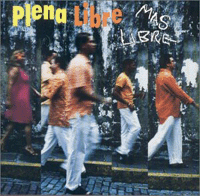
PLENA LIBRE
MAS LIBRE (Ryko Latino)
Plena is a traditional Puerto Rican form that is akin to salsa. This album by Plena Libre also samples musical styles from reggae to samba without getting trite or trendy. It's very well recorded with a rich sound so you can easily distinguish the piano and horn parts from the pounding percussive groove. Guests include "El Canario," Nestor Torres on flute, Charlie Sepulveda on trumpet, and Papo Lucca on piano. It's recorded at a higher level than my other CDs so when I put it on it immediately suggests one thing: "Wind up your waist!"
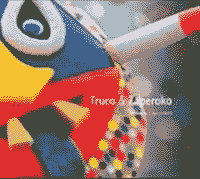
TRUKO Y ZAPEROKO
TRUKO Y ZAPEROKO
(Libertad Records 2003 LE03-826)
Truko and Zaperoco are two separate bands that fused into one entity. Formed twenty years ago, Truko consisted of three brothers Maysonet who played differently pitched drums to produce Plena rhythms, indigenous to Puerto Rico. About the same time, inspired by the Songo music of Los Van Van, Zaperoko returned to his native Puerto Rico and put together a jazz band with heavy trombones to play Latin fusion music. When the two bands met, it seemed like each had something the other needed and so they united. This is their first album on a new label out of Pennsylvania. It is handsomely packaged and annotated and contains a lot of lively music including songs by tres-player Pancho Amat, Brazilian Chico Buarque, traditional tunes and original compositions. A great introduction to this band and a very tasty collection of plena and Latin jazz.
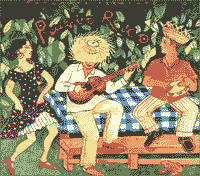
VARIOUS ARTISTS
PUTUMAYO PRESENTS PUERTO RICO
One more release of non-Cuban salsa is PUTUMAYO PRESENTS PUERTO RICO, a solid collection of Bomba, Plena, Son and other forms of salsa from the enchanted isle. (As usual, it has one of those putrid Putumayo covers painted by Nicola Heindl. I guess they sell well but I have yet to meet anyone who finds them attractive or even artistically competent.) The first cut is the deepest. That's Eddie Palmieri's "Café". A simple ode to coffee, this version was recorded in 1998, though the original by his La Perfecta band of the sixties is a Latin dance classic (& was even covered by OK Jazz in Zaire). Trombonist Jimmy Bosch is another New Yorker of Puerto Rican descent, his "Pa mantener tradicion" is a funky jam but "cheats" in that it has Cubans Chucho Valdes on piano and Nelson Gonzalez on tres. I guess it says a lot for the cross-pollination of Latin musical styles, especially in the cauldron of New York. Modesto Cepeda, who was born on the island, plays a folkloric gem "Homenaje a Caridad." The pace slows down for a ballad "Seis Milonguero" by cuatro player Edwin Colon Zayas, beautifully rendered in a style that derives from Argentinian music. There's a bomba jam to end. While not on the level of PUTUMAYO PRESENTS LA REPUBLICA DOMINICANA (also compiled by Jacob Edgar), this is an important slice of salsa and one you'll want to explore.